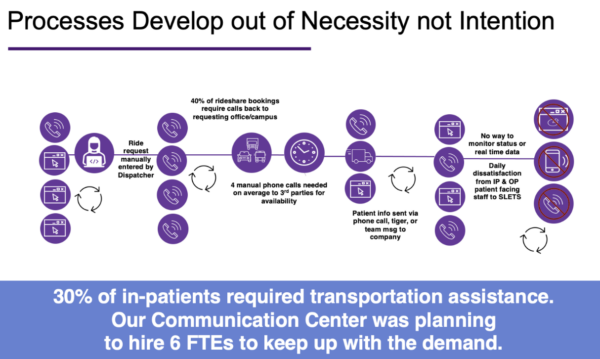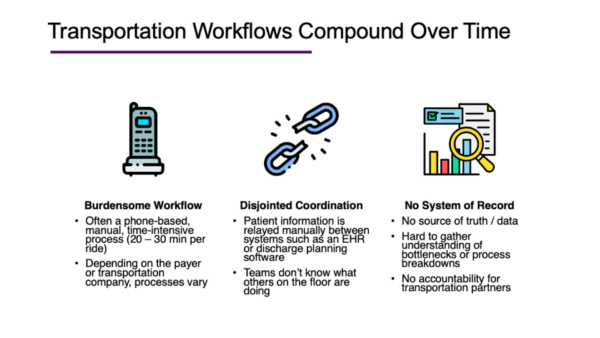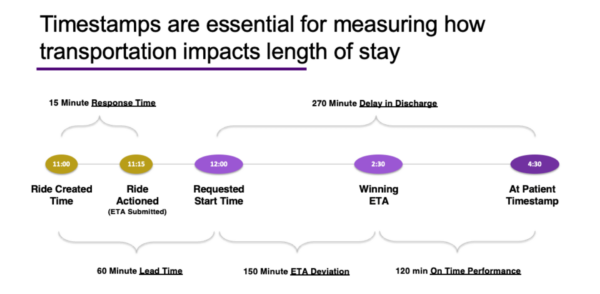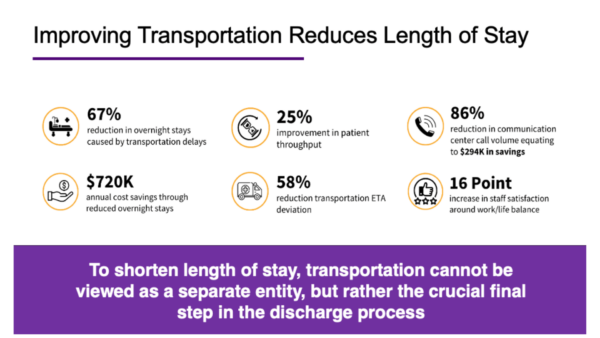Optimizing Patient Flow through Targeted Workflow Improvements: Recapping our CMSA Poster Presentation
Patient transportation often emerges as a hurdle to timely patient discharge. At St. Luke’s University Health System (SLUHN), this challenge loomed large, impeding the seamless flow of patients through the improved continuum of care. The Communication Center struggled to keep pace amidst a rapidly growing demand from the system, already clocking in with 30% of inpatients needing transportation assistance.

Operating conditions resembled a perpetual state of urgency, with resources stretched thin and staff feeling the strain. Compounding the issue was the absence of a centralized system of record, leaving teams scrambling to manage transportation requests and schedules efficiently.

Using Patient Transportation Data to Reduce Length of Stay
Enter data – the unsung hero in the quest for operational efficiency. SLUHN recognized that to truly revolutionize transportation and reduce the length of stay, a paradigm shift was needed. They reframed patient transportation not as a standalone function but as an integral part of the discharge process, intrinsically linked to patient outcomes.
Integrating existing software systems with a transportation management software, allowed for a completely redesigned workflow and seamless transfer of data between parties in the transportation workflow, capturing essential information necessary to continue to iterate their process.
Transportation metrics unveiled a slew of inefficiencies, shedding light on delays and bottlenecks previously unmeasurable.
- The lead time represents the duration between initiating a request for transportation and the desired pick-up time.
- Response time signifies the interval from initiating the request to receiving confirmation from a transportation provider.
- The winning ETA reflects the agreed-upon time for patient pick-up, while the ETA deviation quantifies any deviation from the originally planned pick-up time.

By dissecting these data points, SLUHN unearthed hidden delays and inefficiencies, paving the way for targeted interventions. They identified systemic issues contributing to prolonged lead times, such as inadequate notice periods and fragmented communication channels. Response times were optimized through streamlined processes and enhanced accessibility to ride requests. Moreover, objective measures of on-time performance were implemented, ensuring accountability and rewarding excellence among transportation providers.
Using Transportation to Improve Patient Flow
The SLUHN team understood that transformation requires strategic alignment and visionary leadership. Recognizing transportation as a critical enabler of patient flow, SLUHN rallied a cross-functional team to spearhead change. Departmental alignment was paramount, with EMS/SLETS and Care Management operating in lockstep. Leadership buy-in was secured, with stakeholders across the organization lending their support to the cause.
A data-driven strategy paved the way for action, showcasing the tangible impact of optimized transportation on patient outcomes and organizational efficiency. SLUHN shared its vision for success, outlining clear objectives and measurable outcomes.

In the end, SLUHN’s efforts bore fruit. Length of stay plummeted, overnight stays dwindled, and delays became a relic of the past. By reframing patient transportation through a data-driven lens and building a comprehensive strategy, SLUHN improved a once formidable barrier to discharge and harnessed the power of data to drive meaningful improvements in patient care.
Click here to download Roundtrip’s full CMSA poster presentation.

